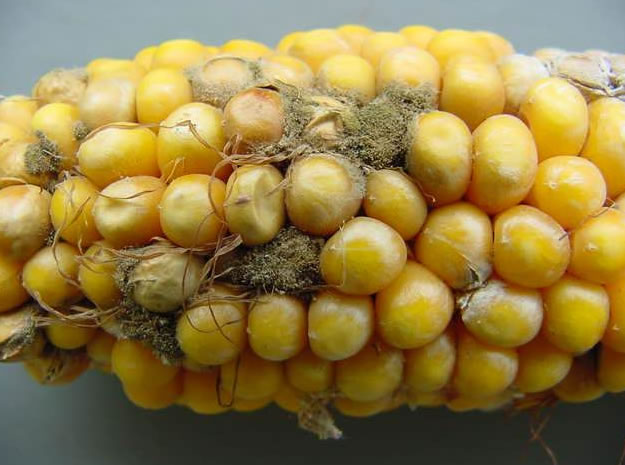August 9, 2012

With high temperatures and dry conditions prevailing during the corn grain-fill period this season, the risk of Aspergillus ear rot is high, said Carl Bradley, University of Illinois plant pathologist.
Aspergillus ear rot, caused by the fungus Aspergillus flavus, is observed as a yellowish-green mold growing on corn kernels. Areas within fields that have insect- and bird-damaged ears are particularly vulnerable to the rot.
Aspergillus flavus produces aflatoxin, a carcinogenic mycotoxin that can be dangerous to animals if it is on the grain they consume. U.S. Food and Drug Administration (FDA) action levels for aflatoxin-contaminated corn grain are listed at http://www.fda.gov/Food/GuidanceComplianceRegulatoryInformation/GuidanceDocuments/ChemicalContaminantsandPesticides/ucm077969.htm#afla.
“If Aspergillus ear rot is observed in a field, it is very important to contact your crop insurance agent before harvesting,” Bradley said. “Crop insurance will not cover losses due to aflatoxin after grain is placed in storage.” (For more information on this topic, refer to the article by U of I agricultural and consumer economics professor Gary Schnitkey at http://www.farmdocdaily.illinois.edu/2011/08/crop_insurance_implications_of.html.)
Bradley recommends drying corn affected by Aspergillus ear rot to below 15% moisture immediately after harvest to prevent further mold development and aflatoxin accumulation. Long-term storage should be at slightly below 13% moisture.
Cleaning grain after harvest may reduce the level of aflatoxin in the lot, because broken and cracked kernels tend to have higher levels of aflatoxin. Grain screenings should not be fed to livestock; they are likely to have high concentrations of aflatoxins.
Bradley advises producers to send corn grain and silage samples for aflatoxin testing to the Illinois Department of Agriculture’s Centralia Animal Disease Laboratory (http://www.agr.state.il.us/AnimalHW/labs/centralialab.html). (Note that the Centralia laboratory is scheduled to close later this year, and services will move to the Galesburg Animal Disease Laboratory; its website is at http://www.agr.state.il.us/AnimalHW/labs/galesburglab.html.)
For more information about Aspergillus ear rot, aflatoxin, and other corn-ear molds and mycotoxins, the Plant Management Network’s Focus on Corn section has an online presentation by Charles Woloshuk (Purdue University) at http://bit.ly/RlmtmH.
You May Also Like




